In the wake of massive floods caused by Hurricane Harvey, the Department of Labor (DOL), Internal Revenue Service (IRS), and Pension Benefit Guaranty Corporation (PBGC) have issued initial employee benefit plan guidance. The temporary relief provided in the guidance relates to such things as hardship distributions, plan loans, filing deadlines, plan deposits, and notice requirements. Plan sponsors and administrators with participants or beneficiaries who live or work in the disaster zone should consider whether to implement this temporary relief. A summary of the guidance is provided below.
Qualified Plan Loan, Hardship, and Other Distribution Procedures
IRS Announcement 2017-11 allows for relaxed rules concerning hardship distributions, plan loans, and other plan distributions made on or after August 23, 2017 through January 31, 2018. Key components of this relief include the following:
-
Hurricane Harvey relief is available to participants who work or live in the designated disaster area. Additionally, relief is available for participants with relatives (spouses, children, parents, grandparents and other dependents) who work or live in the designated disaster area.
-
Plans must be amended before the end of the first plan year beginning after December 31, 2017 (by December 31, 2018 for calendar year plans) to allow Hurricane Harvey hardship distributions or, if the plan document does not currently permit plan loans, to allow plan loans.
-
Hardship Distributions:
-
A qualified retirement plan (such as a 401(k) plan) may make a hardship distribution based on an affected participant’s representation that the distribution is needed due to Hurricane Harvey. Hurricane Harvey hardship distributions are not limited to the events listed in IRS regulations. This means that affected participants can access their plan accounts to pay for such things as temporary lodging, replacement clothing, and food.
-
If a participant takes a Hurricane Harvey hardship distribution, the plan will not be required to impose a six-month suspension of elective deferrals, as would otherwise be required under IRS regulations.
-
-
Plan Loans and Other Distributions
-
A retirement plan may disregard procedural requirements for plan loans and other distributions made to participants and beneficiaries affected by Hurricane Harvey, so long as the plan administrator takes reasonable steps to obtain required documentation as soon as practicable. This does not mean that such things as the spousal consent requirement are waived. It does mean, however, that a plan may temporarily disregard the need to follow plan loan or distribution procedural requirements or delay getting required documentation from an affected participant or beneficiary until it is practicable to obtain the required documentation.
-
Form 5500 Filing Relief
Hurricane Harvey disaster relief includes a delay in the filing deadline for Form 5500s that were or are required to be filed on or after August 23, 2017 and before January 31, 2018. Plan administrators who are unable to obtain on a timely basis the information they need to complete Form 5500s because of the disaster caused by Hurricane Harvey will have until January 31, 2018 to file their Form 5500s.
Deposit of Participant Contributions and Plan Loan Repayments
Under DOL regulations, participant contributions and plan loan repayments must be forwarded to the plan as soon as possible after they are received, but no later than the fifteenth business day of the following month. As part of its Hurricane Harvey disaster relief, DOL has said that it will not pursue claims under Title I of ERISA with respect to temporary delays in forwarding contributions and plan loan repayments that are caused by Hurricane Harvey. Employers and service providers should forward these contributions and plan loan repayments as soon as possible, as the relief applies only to the extent that affected employers and service providers act reasonably, prudently, and in the interests of participants to comply “as soon as practical under the circumstances.”
Blackout Notices
DOL also provided relief with respect to plan blackout notices. Normally, a plan administrator must provide 30 days’ advance written notice when participants’ or beneficiaries’ rights to direct investments or obtain loans or other distributions from a plan will be temporarily suspended or restricted by a blackout period. However, blackout notices are not required when a plan fiduciary determines in writing that advance notice cannot be made due to events beyond the plan administrator’s control. Because hurricanes are beyond the control of a plan administrator, DOL will not allege a violation of the blackout notice requirement solely because a plan fiduciary did not make a written determination that notices cannot be provided.
PBGC Hurricane Harvey Relief
PBGC’s Hurricane Harvey relief waives certain penalties and deadlines applicable to single-employer and multiemployer defined benefit pension plan administrators and others who are responsible for meeting PBGC deadlines. The relief applies to these parties if they are located in the disaster zone or if they cannot get required information from service providers located in the disaster zone.
PBGC’s relief extends to January 31, 2018 the deadline for the following if their deadlines were on or after August 23, 2017 and before January 31, 2018:
-
Filing reportable event post-event notices with the PBGC;
-
Requesting reconsideration or appeal of a PBGC determination;
-
Paying PBGC premiums (late payment penalties are waived, but not applicable interest charges);
-
Filing a standard termination notice (Form 500) or distressed termination notice (Form 601);
-
Completing the distribution of plan assets in a standard termination and filing the post-distribution certification (Form 501);
-
Filing a distress termination notice (Form 601); and
-
Making multiemployer plan PBGC filings and notices to persons other than PBGC.
In addition, the PBGC will grant other relief to pension plans on a case-by-case basis.
The full text of the DOL’s and the IRS’s Hurricane Harvey guidance is available on EBSA’s disaster relief website, and PBGC’s guidance is available on its website. The DOL has also prepared a set of “FAQs for Participants and Beneficiaries Following Hurricane Harvey.”
We anticipate the release of additional guidance concerning benefit plan relief in the coming weeks and months.



 />i
/>i
